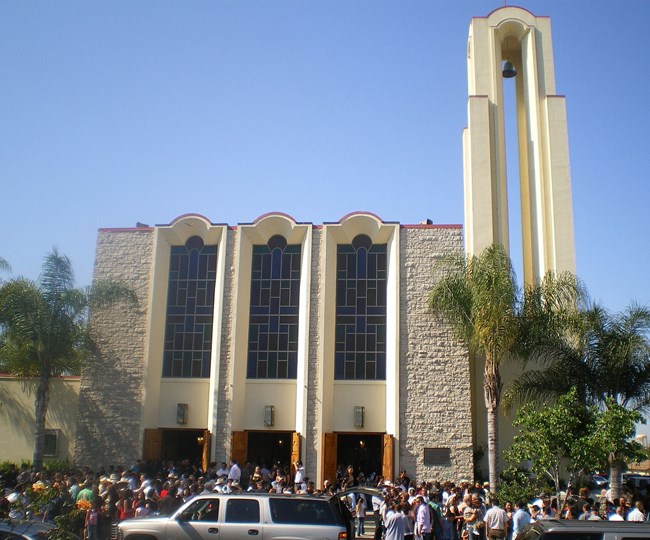Article
Mothers of East Los Angeles

Photo by Los Angeles, CC BY-SA 4.0.
What does it mean to protect your children? What should a society do when young people are threatened?
Latina residents of eastern Los Angeles founded the “Mothers of East Los Angeles” (MELA) to protest a prison that the state of California planned to build near their homes. After winning that battle, they mobilized to stop other threats to their neighborhood environment, including a toxic waste incinerator and an oil pipeline. Members of the group were pioneers in the fight against environmental racism.
"No Prison in ELA"
In the mid-1980s, California announced plans to build a new prison in East Los Angeles. The selected site was close to the historically Chicano neighborhood of Boyle Heights. Many residents were furious when they heard about the plan. They worried that the prison would prove dangerous to local families.
Residents also remembered previous development involving their neighborhood. Twenty years earlier, California had built a large freeway through East Los Angeles. The new roads displaced thousands of Boyle Heights residents and created air and noise pollution for those who remained.
A group of local women, including Aurora Castillo, Juana Beatríz Gutiérrez, and Lucy Ramos, decided to protest the prison plan. They pointed out that whiter and wealthier neighborhoods had been able to successfully resist similar projects. Gutiérrez explained:
"In the past, people didn't fight back because they thought that if the government said something it would be done and there was nothing you could do about it. Now that we're organized and informed, they won't be able to do to our barrio what they've done before.''
The Mothers
On a suggestion from a local priest named John Moretta, the women began calling themselves “Mothers of East Los Angeles,” or MELA for short. They organized protest marches with women from the neighborhood front and center. Every Monday for several months, the group—sometimes hundreds strong—led marches across the LA River on Olympic Boulevard.[1] Sometimes they wore white scarves over their heads and held lit candles, creating a solemn atmosphere. Often they brought their children. They also organized letter-writing campaigns and lobbied state legislators in Sacramento.[2]
MELA had chosen its name carefully. Its members placed their identities as mothers front and center. Even those who did not have children framed their activism in terms of protecting kids and families. Co-founder Aurora Castillo explained:
"It was not just our children we were fighting for but also the health and well-being of whole future generations. A Hispanic mother will turn into a lioness if her cub is threatened."
In this way, MELA was part of a long tradition of women’s activism that uses women’s roles as mothers, caregivers, and nurturers to argue for political change.The pressure worked and the Mothers won their first battle. California canceled the prison project. But new fights were already on the horizon.
"Don't Poison Me"
Soon the Mothers were mobilizing again, this time against a different threat: a waste incinerator planned for the nearby city of Vernon. MELA and its allies argued that the facility would emit toxic chemicals into the air of nearby Latino and Black neighborhoods. They continued their tactics of protest and petitioning. They also decided to challenge the project in court. New attention to the project raised public awareness and concern about the risks of burning waste. After a court defeat, the company abandoned the effort. In partnership with environmental groups, MELA used the same tactics to oppose a planned oil pipeline through the region.
In the 1990s, MELA split into two groups: one using the original name, and one called Madres del Este de Los Angeles, Santa Isabel. The two groups disagreed on several issues, including who had the right to use the MELA name and who should be credited as the founders. Although their members did not always get along, both organizations remained active in community projects and committed to the neighborhood.
The Mothers of East Los Angeles were leaders in a growing movement protesting environmental racism and demanding better conditions for their families and communities. Women of color continue to lead the fight for environmental justice in the 21st century.
Notes
[1] The Sears, Roebuck & Company Mail Order Building (Los Angeles, CA), located along the route of the MELA marches along Olympic Boulevard, was added to the National Register of Historic Places on April 21, 2006.
[2] The California State Capitol was added to the National Register of Historic Places on April 3, 1973.
Bibliography
Gold, Matea. “The Mothers’ Saga: How a Movement Split in Two.” Los Angeles Times, Aug. 29, 1991.
Guide to the Juana Beatriz Gutierrez Mothers of East Los Angeles (MELA) Collection - https://oac.cdlib.org/findaid/ark:/13030/c88p62qd/entire_text/
Gutierrez, Gabriel. “Mothers of East Los Angeles Fight Back.” In Unequal Protection: Environmental Justice and Communities of Color, ed. Robert D. Bullard. San Francisco: Sierra Club Books, 1994.
"Mothers' Group Fights Back in Los Angeles," New York Times, Dec. 5, 1989.
Pardo, Mary S. Mexican American Women Activists: Identity and Resistance in Two Los Angeles Communities. Philadelphia: Temple University Press, 1998.
Swart, Betsy. “The Passion of Aurora Castillo: The Militant Mothers of East L.A.” https://web.archive.org/web/20130927210647/http://www.socialjusticephotography.com/images/militant_mothers.pdf?b6e672e0
